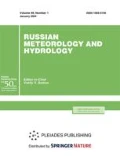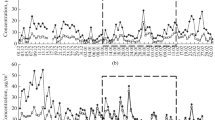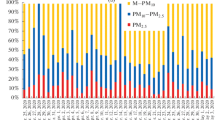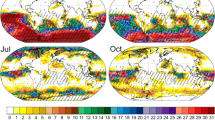Abstract
Changes in the atmospheric electricity characteristics (AECs) during the spring of 2020 in the urban, suburban, and very low human impact areas (Irkutsk, Irkutsk oblast; Voeikovo, Leningrad oblast; Tiksi, Republic of Sakha) are considered. Based on the AEC data, a theoretical assessment of the change in aerosol concentrations at these sites was carried out. Apparently, the decline in economic activity associated with the measures to prevent the expansion of COVID-19 significantly decreased the concentration of airborne particles in cities and suburban regions.
Similar content being viewed by others
INTRODUCTION
Theoretical studies of the aerosol pollution effects on the atmospheric electricity characteristics (AECs) were performed both by foreign [2, 13, 21] and Russian scientists [6–8, 20]. Routine observations of the AECs in Russia have been conducted for more than 70 years. Over this period, the large volume of data was accumulated, whose analysis was presented in many papers, in particular, the interrelation of the AECs with the atmospheric pollution was investigated [5, 8, 15, 16, 18, 22]. The impact of aerosol concentration on the electrical conductivity of air (\(\lambda\)) and the atmospheric electric field strength (\(E\)) was shown. It was noted that the greatest role is played by submicron airborne particles (\(\sim 3{-}200\) nm).
Scientific publications note the considerable decrease in the electrical conductivity of air according to observations in the North Atlantic. For example, the values of total electrical conductivity of air \(\sim\)30 fS/m were obtained in 1910–1920 [23], whereas the values of \(\Sigma \lambda\) in the 1960s–1980s dropped to 20 fS/m [3]. This fact may be considered as an effect of the potential increase in the pollutant concentration on a global scale.
The results of the AEC observations during the period of increased measures to prevent the COVID-19 expansion in April–May 2020 are presented. The supposition is made that a dramatic reduction of aerosol emissions to the atmosphere occurred at that time due to the traffic flow decrease and the suspension of operations in various fields of activity.
DESCRIPTION OF THE EXPERIMENT
Data on the atmospheric electricity characteristics were received from the atmospheric electricity observation stations. All measurements were carried out using identical instruments, namely, Pole-2M electric field strength meter and Elektroprovodnost’-2M air electrical conductivity meter, which are the components of the atmospheric electricity measuring system. Both devices were developed at Voeikov Main Geophysical Observatory (MGO) and were registered in the State Register of Measuring Instruments [19]. The measurements are continuous, all minute-averaged measurement data are transmitted to the Atmospheric Electricity subject server.
Data from three stations located in different geographical regions were analyzed. Irkutsk station (57.6° N, 61.1° E, 288 m above sea level) is located in the large regional center, in whose suburbs an anthropogenic impact is most strongly pronounced. Voeikovo station (59.9° N, 30.6° E, 70 m) is situated on the plain, in the suburb 10 km east of Saint Petersburg; it allows monitoring the influence of airborne particles depending on wind direction: if the wind blows from the city and neighboring industrial zones, the air electrical conductivity is 1.5–2 times lower than when the wind blows from Lake Ladoga and woodlands [18]. Tiksi station is the high-latitude one (71.6° N, 128.9° E, 7 m), it is located on the Arctic Ocean coast, far from major industrial centers, which, in turn, makes it possible to assess a possible anthropogenic impact on measurement data [4].
The term “fair weather” is common in scientific community in the studies of the electrical state of the atmosphere. The values of electrical characteristics obtained in fair weather are commonly called normal. Such weather conditions are characterized by the absence of thunderstorms, precipitation, frost, rime ice, fog, heavy and moderate haze and mist (visibility \(>\)4 km), low-level clouds, especially cumulus ones (total cloud amount \({\le}3/10\)), as well as by the absence of blizzard, blowing snow, dust wind, and wind with a speed \(>\)6 m/s [14, 15].
The information about the AECs in so called calm hours [12], which partly meet fair weather conditions, namely, exclude the impact of weather phenomena on surface electricity fluctuations, was used for processing observation data. Measurement data for calm hours are an indicator of the background state and yearly published in the reports on environmental conditions in the Russian Federation [10].
EXPERIMENTAL DATA
The daily variations in the AECs from April to May for every year since 2015 were considered during the experiment (Fig. 1). At some stations, data are absent for different years and different parameters, which is associated either with an incorrect operation of measuring instruments or with repair works. In addition, data averaged by weeks over the period from February to July in 2020 were compared with data for 2015–2019 (Fig. 2). The dependence of air electrical conductivity \(\Sigma \lambda\) on wind direction was also analyzed for Voeikovo station (Fig. 3). The analysis of daily variations in the electric field strength \(E\) showed that at Voeikovo and Irkutsk stations they almost coincide in 2020 with daily variations for the same period averaged over 5 years, with an insignificant decrease in the absolute value of \(E\). At Tiksi station, the values of \(E\) in 2020 are slightly smaller, which may be associated with the reduced volume of data as a result of the sampling following fair-weather criteria, namely, with significant precipitation in that period. As follows from Fig. 1, at Voeikovo and Irkutsk stations, there was a significant increase in \(\Sigma \lambda\) in 2020 as compared to the data averaged over the same period (April–May) in 2015–2019. At Tiksi station, the values of \(\Sigma \lambda\) almost did not change.
The daily variations in (a, c, e) total electrical conductivity \(\Sigma \lambda\) and (b, d, f) electric field strength \(E\) during the period from April to May in 2015–2020 at (a, b) Tiksi, (c, d) Voeikovo, and (e, f) Irkutsk stations. Coordinated Universal Time is given on the \(y\)-axis. (1) 2015; (2) 2016; (3) 2017; (4) 2018; (5) 2019; (6) 2020
(1) The average weekly values of (a, c, e) total electrical conductivity \(\Sigma \lambda\) and (b, d, f) electric field strength \(E\) during the period from January 4 to August 29, 2020 and (2) the mean values for the same period over the preceding 5 years (2015–2019) at (a, b) Tiksi, (c, d) Voeikovo, and (e, f) Irkutsk stations. \(n\) is the week number
The number of calm hours for different years and stations is the following:
...
Year | 2015 | 2016 | 2017 | 2018 | 2019 | 2020 |
Voeikovo | 1065 | 1025 | 1252 | 1299 | 1089 | 1099 |
Irkutsk | 1176 | 1141 | 1160 | 1047 | 1016 | 967 |
Tiksi | 957 | 974 | 1042 | 834 | 584 | 413 |
It is clear that the sample volume at Voeikovo and Irkutsk stations in 2020 is comparable with those for the previous years. For Tiksi station, this volume in 2019 and 2020 is twice smaller than in the preceding years. This is caused by the fact that according to the weather station data, the number of blizzards has increased in the recent years of the analyzed period. Despite this, it may be concluded that the values presented on the graphs are statistically significant at all stations and there are certain dependences.
Proceeding from the revealed fact of the dependence of \(\Sigma \lambda\) on the aerosol impact, a supposition was made about an increase in \(\Sigma \lambda\) caused by the introduction of quarantine measures limiting economic activity, including the traffic movement.
For assessing the impact of quarantine measures on the AECs, the changes in these characteristics with the pandemic development were monitored from January 4 (the second week of the year) to August 29, 2020 (the 34th week), which are presented in Fig. 2. The weekly data were averaged by the criteria of calm hours used for the background monitoring.
The enhanced quarantine measures started being introduced from March 23–26, i.e., from the 13th week of the year. As follows from the graphs, the values of \(\lambda\) in that period started exceeding those for the similar period in the previous 5 years at Voeikovo and Irkutsk stations. This tendency continued until the 27th–29th weeks, when the removal of restrictions and the partial renewal of economic activity started in the regions. At Tiksi station, the AEC values almost did not vary. Perhaps, this was associated with the fact that, unlike the other stations, it is located on the coast in the zone least subjected to anthropogenic impact, and there is no economic activity in its vicinity.
A decreasing intensity of the aerosol impact as a result of the introduction of enhanced quarantine measured limiting economic activity, including the traffic flow, is well illustrated in Fig. 3, which presents the dependence of \(\Sigma \lambda\) on wind direction at Voeikovo station.
According to 5-year average data (curve 2), the impact of the industrial megalopolis Saint Petersburg is clearly observed. For western wind directions (namely, WNW–SSW), the values of \(\Sigma \lambda\) are much smaller than those for the wind from “pure” directions (woodlands and Lake Ladoga). The values for 2020 (curve 1) are much higher than the previous ones: this exceeding is \(\sim\)30% for the wind from Saint Petersburg and \(<\)10% for the wind from “pure” directions. The only direction for which the values were comparable is ESE, which is perhaps associated with the smallest number of cases registered from this direction (2–3%).
It should be noted that the number of cases for each direction, which were registered at Voeikovo station in April–May 2020, in percentage terms rather well coincides with the number of cases for the same months during 2015–2019 (the Pearson’s correlation coefficient \(R = 0.84\)). The prevalent directions were western in the WSW–WNW sector, the frequent cases of the NNE direction may also distinguished.
THEORETICAL ESTIMATES OF AIRBORNE PARTICLE CONCENTRATION VARIATIONS
The equation describing the relationship between the concentration of aeroions and the concentration of airborne particles for a nonstationary case has the following form [1]:
where \(n_{\pm }\) is the concentration of positive and negative light aeroions; \(q\) is ion generation intensity; \(N\) is the concentration of airborne particles; \(\alpha\) is the coefficient of recombination of positive and negative light ions; \(\beta\) is the coefficient of attachment of light ions to airborne particles.
The relationship between the values of polar electrical conductivity of air and the concentration of aeroions looks as follows:
where \(\lambda _{\pm }\) is the positive and negative air electrical conductivity; \(e\) is the electron charge; \(b_{\pm }\) is the mobility of positive and negative light aeroions [8].
When Elektroprovodnost’-2M meter was developed, to prevent the transition of the instrument to saturation, the maximum value of mobility of aeroions of both signs was equal to \(b_{ + }=b_{-}= 2 \times 10^{-4}\) V/(m2 s) (Research Report, 2008). The values of mobility of light ions are distributed within \((1 - 2) \times 10^{-4}\) V/(m2 s) [2, 9], and the mean values are \(b_{ + } = 1.36 \times 10^{-4}\) V/(m2 s), \(b_{-} = 1.56 \times 10^{-4}\) V/(m2 s) [7]. Taking this into account and proceeding to the stationary form (\(d/dt = 0\)), we get the equation for the concentration of airborne particles from expressions (1), (2):
For Aitken nuclei, whose effect on electrical conductivity is the most pronounced, \(\beta = 1.65 \times 10^{-12}\) m\(^{3}\)/s [7]. Knowing the mean values of air electrical conductivity for the previous years and for the analyzed year, as well as assuming that the ion generation intensity remained unchanged (\(q = 10^{7}\) m\(^{-3}\) s\(^{-1}\)), for \(\alpha = 1.6 \times 10^{-12}\) m\(^{-3}\) s\(^{-1}\) [1] we get that during the period of taking measures to prevent the COVID-19 expansion the concentration of aerosol particles decreased by 25% in Voeikovo and by 35% in Irkutsk. At the same time, using this method for estimating the concentration of aerosol transported from Saint Petersburg, we obtain that emissions decreased by 30%.
To verify this method for estimating the aerosol contamination, the calculation of concentrations was carried out for the data published in [8]. The mean aerosol concentration obtained experimentally is 20% higher than that calculated using (3) (\(6.2 \times 10^{9}\) and \(5.2 \times 10^{9}\) m\(^{-3}\), respectively). It should be emphasized that the measurement results can be affected by the errors of measuring instruments, which makes up 10% for Elektroprovodnost’-2M meter and 20% for the aerosol diffusion spectrometer.
CONCLUSIONS
The study demonstrates that during the period of enhanced measures to prevent the COVID-19 expansion air electrical conductivity increased relative to the mean values for the previous years. This increase by 25 and 20% was experimentally found for Voeikovo and Irkutsk stations, respectively. At Tiksi station, the changes were insignificant (\(<\)3%). The impact on the electric field strength remained within the standard deviation for each analyzed station.
Theoretical estimates of submicron airborne particle concentrations showed that for Voeikovo, emissions decreased by 25% due to a significant reduction (by 30%) of emissions from Saint Petersburg. For Irkutsk, the emission reduction made up 35%.
Although the presented calculations do not take into account the effects of larger aerosol (which can also affect the electric structure of the surface layer as well as the change in the aeroion mobility caused by the ambient temperature and pressure fluctuations), the estimates of aerosol particle concentrations can be considered reliable.
REFERENCES
The Atmosphere. Reference Book (Reference Data, Models), Ed. by Yu. S. Sedunov, S. I. Avdyushin, E. P. Borisenkov, O. A. Volkovitskii, N. N. Petrov, R. G. Reitenbakh, V. I. Smirnov, and A. A. Chernikov (Gidrometeoizdat, Leningrad, 1991) [in Russian].
J. Bricard, “Action of Radioactivity and of Pollution upon Parameters of Atmospheric Electricity,” in Proceedings of the 3rd International Conference on Atmospheric and Space Electricity (Gidrometeoizdat, Leningrad, 1969) [Transl. from English].
G. P. Vayushina, I. M. Legashov, and Ya. M. Shvarts, “Atmospheric Electricity Observations over the Ocean as a Component of the General System of Routine Atmospheric Electricity Observations,” in Problems of Atmospheric Electricity (Gidrometeoizdat, Leningrad, 1990) [in Russian].
B. G. Zainetdinov, “Observations of Electrical Characteristics of the Surface Atmospheric Layer in the Polar Region,” Trudy GGO, No. 588 (2018) [in Russian].
N. N. Klimin and Ya. M. Shvarts, “Estimates of Trends in Surface Atmospheric Electricity for 1916–1992,” Meteorol. Gidrol., No. 11 (1996) [Russ. Meteorol. Hydrol., No. 11 (1996)].
V. N. Morozov, “Atmospheric Aerosols as Amplifiers of Atmospheric Electric Field,” in Natural and Anthropogenic Aerosol (Proceedings of International Conference) (NII Khimii, St. Petersburg, 1998) [in Russian].
V. N. Morozov, Mathematical Modeling of Atmospheric Electricity Processes Taking into Account Airborne Particle Effects (RGGMU, St. Petersburg, 2011) [in Russian].
V. N. Morozov, B. G. Zainetdinov, L. G. Sokolenko, A. A. Palei, and Yu. V. Pisanko, “Experimental and Theoretical Studies of Submicron Aerosol Particle Effects on the Surface Layer Electricity,” Trudy GGO, No. 590 (2018) [in Russian].
V. M. Muchnik and B. E. Fishman, Electrification of Coarse Aerosol (Gidrometeoizdat, Leningrad, 1982) [in Russian].
Review of Environmental Conditions and Pollution in the Russian Federation in 2019, Ed. by G. M. Chernogaeva (Roshydromet, Moscow, 2020) [in Russian].
I. B. Popov, “Peculiarities of Air Electrical Conductivity Variations near Saint Petersburg,” Trudy GGO, No. 563 (2011) [in Russian].
I. B. Popov, “Statistical Estimates of the Impact of Different Weather Phenomena on the Atmospheric Electric Potential Gradient,” Trudy GGO, No. 558 (2008) [in Russian].
P. C. Reist, Introduction to Aerosol Science (Mir, Moscow, 1987) [Transl. from English].
Results of Ground-based Atmospheric Electricity Observations (Global Network) (GGO, Leningrad, 1984) [in Russian].
K. A. Semenov, “Effects of Local Conditions on Atmospheric Electricity Elements,” Trudy GGO, No. 323 (1974) [in Russian].
K. A. Semenov, “The Connection between Atmospheric Electricity Elements and Air Pollution,” in Proceedings of the 1st All-Union Symposium on Atmospheric Electricity (Gidrometeoizdat, Leningrad, 1976) [in Russian].
K. A. Semenov, L. G. Sokolenko, and Ya. M. Shvarts, “Investigating an Instrument for Air Electrical Conductivity Measurements,” Trudy GGO, No. 424 (1980) [in Russian].
K. A. Semenov, Ya. M. Shvarts, M. P. Zhukova, L. G. Sokolenko, and V. A. Kamyshanova, “Peculiarities of Measurements of Atmospheric Electricity Parameters in Voeikovo,” Trudy GGO, No. 498 (1986) [in Russian].
L. G. Sokolenko and B. G. Zainetdinov, “Results of Modernizing and Expanding the Atmosperic Electricity Observation Network,” Trudy GGO, No. 589 (2018) [in Russian].
Kh. F. Tammet, “Electric Parameters of Air Pollution,” Uchenye Zapiski Tartusskogo Univesriteta, No. 443 (1977) [in Russian].
J. A. Chalmers, Atmospheric Electricity (Gidrometeoizdat, Leningrad, 1974) [in Russian].
Ya. M. Shvarts and L. G. Sokolenko, “Results of Long-term Measurements of Atmospheric Electric Potential Gradient and Specific Polar Air Electrical Conductivities in the Surface Layer in Russia,” in Design and Technology of Electronic Devices. Spec. Issue: Atmospheric Electricity (2004) [in Russian].
W. E. Cobb and H. J. Wells, “The Electrical Conductivity of Oceanic Air and Its Correlation to Global Atmospheric Pollution,” J. Atmos. Sci., No. 5, 27 (1970).
Author information
Authors and Affiliations
Corresponding author
Additional information
Translated from Meteorologiya i Gidrologiya, 2022, No. 3, pp. 47-54. https://doi.org/10.52002/0130-2906-2022-3-47-54.
About this article
Cite this article
Zainetdinov, B.G., Sokolenko, L.G. & Zanyukov, V.V. Changes in Atmospheric Electricity Characteristics in Different Geographic Regions during the Economic Activity Decline in the Spring of 2020. Russ. Meteorol. Hydrol. 47, 191–196 (2022). https://doi.org/10.3103/S1068373922030049
Received:
Revised:
Accepted:
Published:
Issue Date:
DOI: https://doi.org/10.3103/S1068373922030049







